Description
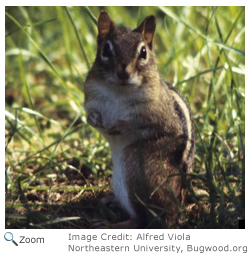 The eastern chipmunk has reddish-brown fur on its back and sides and white fur on its stomach. It has two white stripes bordered by black on its sides and one black stripe on the center of its back. The eastern chipmunk has light stripes above and below its eyes, and it has pouched cheeks that it uses to store and carry food. The eastern chipmunk has reddish-brown fur on its back and sides and white fur on its stomach. It has two white stripes bordered by black on its sides and one black stripe on the center of its back. The eastern chipmunk has light stripes above and below its eyes, and it has pouched cheeks that it uses to store and carry food.
Range 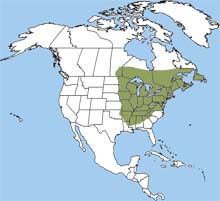 The eastern chipmunk is found in southeastern Canada and most of the the northeastern United States south to Mississippi and Virginia and west to North Dakota and Oklahoma. The eastern chipmunk is found throughout New Hampshire. The eastern chipmunk is found in southeastern Canada and most of the the northeastern United States south to Mississippi and Virginia and west to North Dakota and Oklahoma. The eastern chipmunk is found throughout New Hampshire.
Habitat 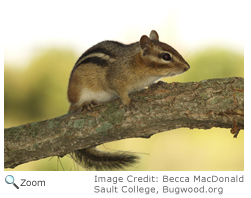 The eastern chipmunk lives in open deciduous forests and at the edges of woodlands. It is also found in bushy and rocky areas near walls, houses, and other buildings. The eastern chipmunk plays an important role in its habitat as a seed disperser! It gathers seeds and carries them to hiding places. As it moves seeds around, it sometimes drops some. These seeds can grow into new plants! The eastern chipmunk lives in open deciduous forests and at the edges of woodlands. It is also found in bushy and rocky areas near walls, houses, and other buildings. The eastern chipmunk plays an important role in its habitat as a seed disperser! It gathers seeds and carries them to hiding places. As it moves seeds around, it sometimes drops some. These seeds can grow into new plants! |
|
| |
| The name chipmunk is probably derived the from both the chattering sound the chipmunk makes and from the Algonquian word atchitamon, which means "one who descends trees headlong." The first recorded use of the word chipmunk didn't happen until around 1841, although a reference to a "chitmunk" is recorded in 1832. |
|
Diet 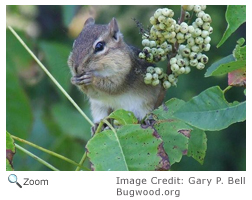 Most of the eastern chipmunk's diet is made up of nuts, acorns, seeds, mushrooms, fruits, berries, and corn. It also eats insects, bird eggs, snails, and small mammals like young mice. In winter, it stays in its den. The eastern chipmunk doesn't truly hibernate, but it does spend a lot of time sleeping. It may wake up every few weeks to eat the food it has stored. Most of the eastern chipmunk's diet is made up of nuts, acorns, seeds, mushrooms, fruits, berries, and corn. It also eats insects, bird eggs, snails, and small mammals like young mice. In winter, it stays in its den. The eastern chipmunk doesn't truly hibernate, but it does spend a lot of time sleeping. It may wake up every few weeks to eat the food it has stored.
Lifecycle 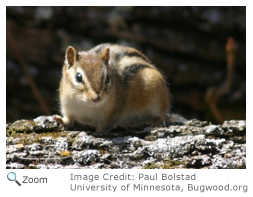 The eastern chipmunk mates in early spring. The female usually has one litter a year with between three and five young. In some areas, a female may have a second litter. The young come above ground when they are about six weeks old. The eastern chipmunk mates in early spring. The female usually has one litter a year with between three and five young. In some areas, a female may have a second litter. The young come above ground when they are about six weeks old.
Behavior
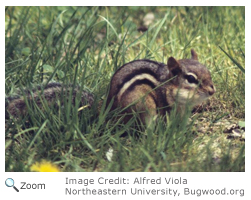 The eastern chipmunk spends a large part of its waking hours gathering and storing food for the winter. The eastern chipmunk is also very vocal and can be heard chattering as it gathers food. The eastern chipmunk spends a large part of its waking hours gathering and storing food for the winter. The eastern chipmunk is also very vocal and can be heard chattering as it gathers food.
|